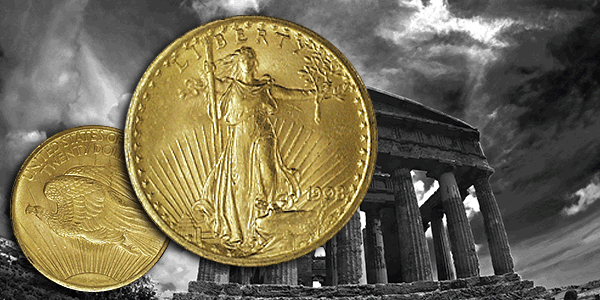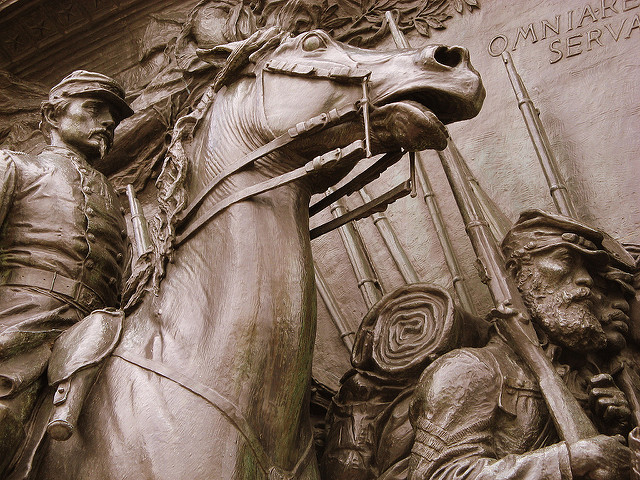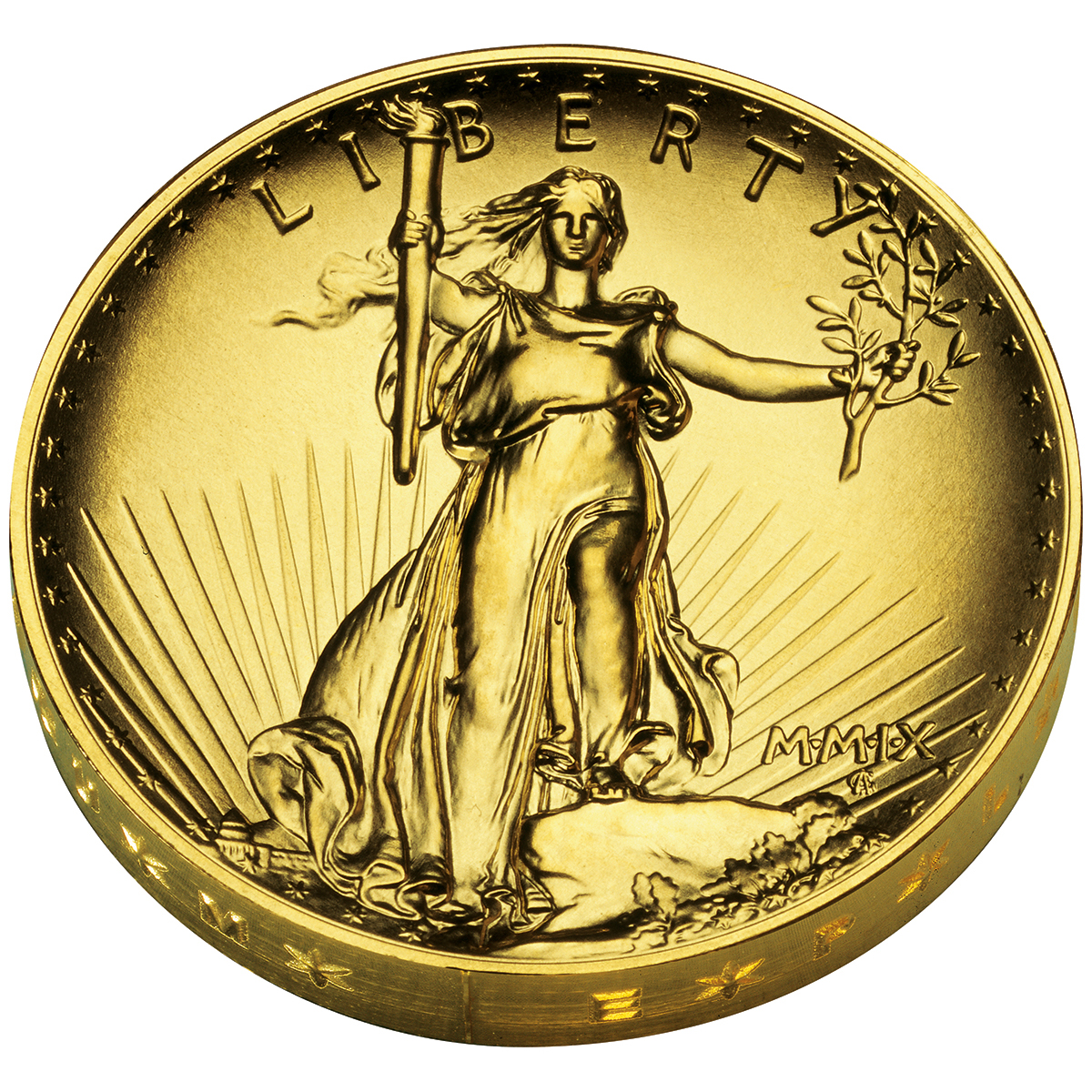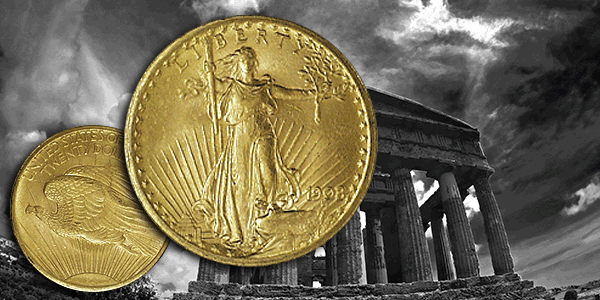An Egyptian King and Augustus Saint-Gaudens Walk into a Bar...
Nov 20th 2018

One of America’s most beautiful coins ever produced owes its creation to Augustus Saint-Gaudens and President Theodore Roosevelt. Minted from 1907 to 1933, the Saint-Gaudens $20 double eagle is sought-after by collectors and for a time, even the Secret Service.
| Shaw Memorial, Boston Massachusettes. Image by debaird™ |  |
A preeminent sculptor of the American Renaissance, the Irish-born Augustus Saint-Gaudens was a mover and shaker in the American art world. From the late 1870s until his death in 1907 at the age of 59, he remained one of the most acclaimed artists of his time. His bronze works were both privately and publicly commissioned and are featured throughout the country; arguably the most notable of which is the Shaw Memorial in Boston -- and for the taphophile with discerning taste, the Adams Memorial located in Rock Creek Cemetery, Washington D.C.
In 1905, Saint-Gaudens was commissioned by President Theodore Roosevelt to design his inaugural Presidential medal. An avid art collector, Roosevelt was pleased by Saint-Gaudens’ efforts. Roosevelt thought circulating American coinage was unattractive and did not reflect the success of America as a democratic, emerging world power. Saint-Gaudens earned himself another commission, one that would redesign the Liberty Head $10 gold eagle and $20 double eagle.
Saint-Gaudens’ golden numismatic masterpiece featured the beautiful figure of Liberty, clad in a gown that skillfully suggested motion, striding purposefully forward clutching an olive branch in one hand and torch held aloft in the other. Its reverse bore a proud eagle, soaring above the rays of a rising sun. His original design was for an ultra-high relief coin in emulation of ancient Greek and Roman coinage, but minting such a design proved to be difficult and only 24 of these experimental coins were ever produced. The relief was lowered twice more before minting began in large quantities. Augustus Saint-Gaudens died before the new double eagles were ready for circulation.
The Philadelphia, Denver and San Francisco Mints chugged along, minting double eagles until 1933. Recorded mintages ranged from as few as 22,000 in 1908 to as high as almost 9 million in 1928. When the Great Depression began in 1929, many Americans began to hoard as much gold and silver coinage as they could.
Forbidden Fruit
The disappearance of gold from circulation was seen as a hindrance to economic growth as by 1933, the Federal Reserve had issued nearly as many Reserve Notes as it had gold to back them. President Franklin D. Roosevelt signed Executive Order 6102, which forbade citizens to hoard gold in any form; however an exception was made for rare coins, jewelers, dentists and the like. While the average American was forced to turn in their gold, Executive Order 6102 also halted all production of gold coins. In 1933, the Philadelphia Mint had already minted 445,000 double eagles. All were ordered to be destroyed, but unbeknownst to Uncle Sam, ten managed to slip through the cracks.
Pilfered and Plundered
Legend has it that a sticky-fingered U.S. Mint cashier was responsible for spiriting the ten double eagles away. Somehow, the never-officially-issued-and-thereby-illegal coins ended up in the possession of Philadelphia jeweler and coin dealer, Israel Switt. As years passed, all ten 1933 double eagles were quietly sold to Switt’s patrons.
The United States government was unaware of the missing coins -- that is until 1944, when an export license was applied for and erroneously granted to collector extraordinaire, Egyptian King Farouk for the sale of a 1933 double eagle. At the time the export license was granted, the significance of the coin’s date had not yet dawned on officials within the U.S. Treasury. When the blunder was discovered, the Secret Service sent agents to ferret out the remaining coins. Eventually, nine coins were found and destroyed.
Ten years later, the massive coin collection of the deposed King Farouk went to auction in Cairo. Amongst the nearly 8,500 gold coins was the lone imported 1933 double eagle. Upon learning that the auction contained the purloined double eagle, the U.S. government demanded that the coin be withdrawn from the sale and returned. The Egyptian government complied, however, the coin disappeared without a trace.

Exhibit A
Decades later, the notorious coin resurfaced. In 1996, Secret Service agents set up a sting operation to purchase the illustrious double eagle from a British coin dealer. The handcuffs came out, the dealer was arrested and the coin was once again in possession of the United States government… but this was not the end of the story. In a lengthy court battle, it was argued that the United States had given written permission (in the form of the export license) for the coin to go into private collection. Ultimately, a settlement was reached and the U.S. Mint agreed that this was the only 1933 double eagle allowed to be privately owned.
In a display of technological minting prowress, in 2009 the U.S. Mint unveiled the Ultra High Relief double eagle as Saint-Gaudens originally intended. Image by United States Mint
On the Auction Block Once More
In 2002, the little coin found its way to auction once more. After the highest bid was placed, an additional $20 fee (for its face value) was added to officially monetize and issue the coin for private ownership. The once illegal coin sold for a tremendous $7.6 million dollars-- making it the second most expensive coin to ever have been sold.
Squirreled Away for a Rainy Day
Perhaps you remember the coin dealer from Philadelphia? Turns out he had a safe-deposit box that lay untouched for more than fifty years. When his heirs opened it, voilà! Inside were TEN more 1933 double eagles! Suffice it to say, Israel Switt’s heirs ended up with the short end of the stick, because there’s one and only one 1933 Saint-Gaudens double eagle that is legal to own.

